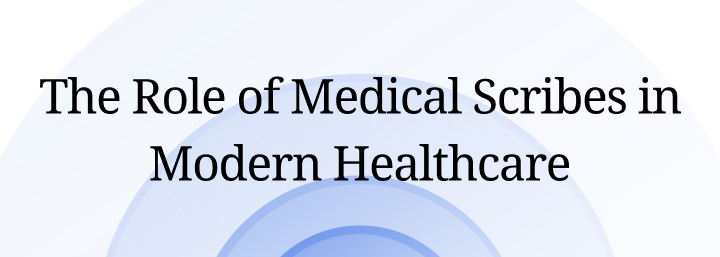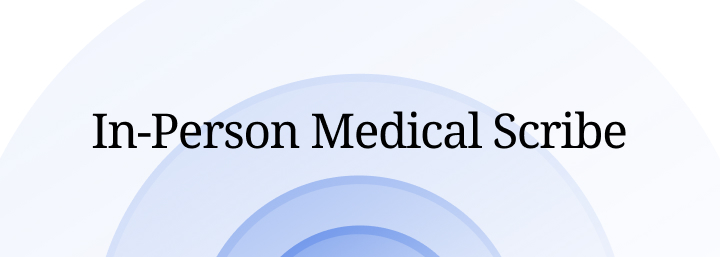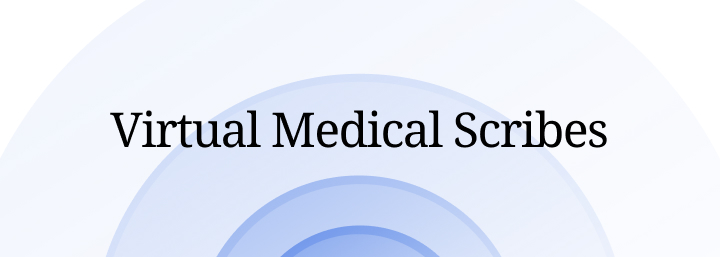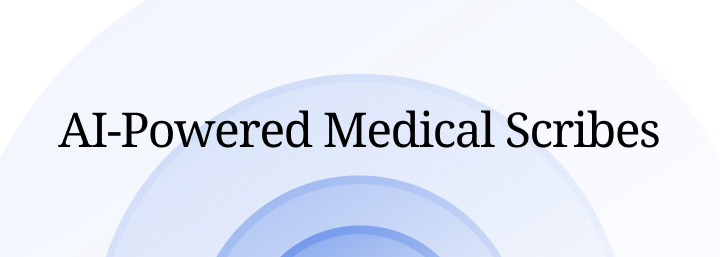Documentation and Administrative Tasks?
In the ever-evolving healthcare landscape, where precision, efficiency, and patient-centered care are paramount, the role of medical professionals continues to expand. Amidst this evolution, a new category of professionals has emerged to revolutionize how healthcare providers operate – medical scribes. In this era of technological advancements, where virtual solutions and AI-driven innovations are reshaping industries, medical scribes have embraced modern tools to enhance their effectiveness.
This comprehensive exploration delves into the dynamic world of medical scribes and their transformative impact on modern healthcare. From traditional in-person support to the virtual realm and the cutting-edge integration of artificial intelligence, this blog post navigates through the diverse landscape of medical scribing. We'll unravel the nuances of each approach, highlighting the benefits, challenges, and potential considerations for healthcare practitioners.

The demand for medical scribes has increased significantly in recent years due to several factors, such as:
Adopting electronic health records (EHRs) and other health information technology systems requires more time and effort to complete documentation and comply with regulations.
Medical information's growing complexity and volume require more attention and detail to capture and record accurately.
The rising expectations and needs of patients who seek more personalized and engaging care from their providers.
The shortage and burnout of healthcare providers face increasing pressure and workload from administrative tasks.
In today's healthcare world, time is often limited, and it's important to document patient interactions carefully. That's where medical scribes come in. They're like a bridge between healthcare providers and taking thorough care of patients. These scribes have special skills that help with the challenge of managing paperwork while keeping patients engaged.
These skilled professionals work with healthcare providers to help with note-taking and other administrative tasks. Doing this lets healthcare providers focus completely on meeting with patients, making diagnoses, and planning treatments. This teamwork makes medical practices work better and makes patients happier, as doctors can give all their attention to them.
Also, medical scribes are important for keeping accurate electronic health records (EHR). They're good at writing down medical words and their observations during treatments. This careful recording lowers the chances of mistakes from rushing. This dedication to accurate record-keeping helps doctors make better choices and lets different parts of the healthcare team share information easily for a patient's care.
Different types of medical scribes are available in the market, depending on their mode of delivery, level of training, scope of service, and cost. The main types of medical scribes are:
| Column A | |
|---|---|
Traditional in-person medical scribes | Individuals physically accompanying the provider during patient encounters document the relevant information in real-time. |
Virtual medical scribes | Individuals who remotely access the provider's audio and video feed during patient encounters and document the relevant information in real-time. |
AI-powered medical scribes | Software applications that use artificial intelligence (AI) technologies, such as natural language processing (NLP), speech recognition, machine learning (ML), and computer vision, generate clinical documentation from provider-patient conversations automatically. |

The concept of in-person medical scribes harks back to the origins of medical documentation. These dedicated professionals are physically present alongside healthcare providers during patient consultations in hospitals, clinics, or other healthcare settings, acting as real-time transcribers and administrative support. With their keen attention to detail, medical knowledge, and quick note-taking abilities, in-person medical scribes accurately capture vital patient information. This traditional approach maintains the personal touch of face-to-face interactions and enables physicians to engage more deeply with patients, unburdened by the need to manage documentation simultaneously.
Using traditional in-person medical scribes in healthcare settings offers a range of tangible benefits, along with certain inherent challenges. Some of the benefits of traditional in-person medical scribes are:
Immediate Feedback: They can quickly provide feedback and clear up any doubts for the healthcare provider during the session.
Non-Verbal Cues: They're skilled at picking up on non-verbal signals and contextual information that might not be easy to hear or see using other methods.
Additional Tasks: They can handle various tasks such as fetching records, arranging tests, setting up appointments, or assisting with referrals.
However, there are also some challenges associated with traditional in-person medical scribes:
Expense: Hiring, training, and keeping these scribes can be costly, especially in places with high demand but few qualified candidates.
Privacy and Security: If not properly screened or supervised, they could create risks related to privacy and security.
Provider-Patient Relationship: If they're not respectful or discreet in their approach, they might negatively impact the relationship between the provider and the patient.
Errors and Inconsistencies: Without familiarity with the provider's style or preferences, they might introduce mistakes or inconsistencies in the documentation.
As the healthcare landscape continues to evolve, practitioners must carefully weigh these benefits and challenges to determine the most suitable approach for their specific practice, considering both the demands of modern patient care and the advancements in medical technology.

In response to the changing dynamics of healthcare and the increasing demand for flexible solutions, virtual medical scribes have emerged as a viable alternative to the traditional in-person model. Virtual medical scribes operate remotely, utilizing technology to connect with healthcare providers during patient interactions. This approach offers practitioners the advantage of seamless integration into existing workflows, eliminating the need for physical space and allowing consultations to occur without interruptions. Virtual scribes are equipped with digital tools to capture medical information efficiently while healthcare professionals concentrate on patient care. This virtual arrangement addresses challenges associated with physical presence and opens doors to broader availability and potential cost savings. However, like any paradigm shift, virtual medical scribes come with their considerations, such as ensuring a secure and compliant technology infrastructure, maintaining effective communication despite the remote setup, and managing potential technical glitches.
The integration of virtual medical scribes into the healthcare field offers a variety of benefits. Here are some of the advantages associated with virtual medical scribes:
Cost and Convenience: They can lower the expenses and challenges of recruiting, training, and overseeing in-person medical scribes.
Enhanced Availability: They can expand the accessibility and adaptability of medical scribe services, covering various places and time zones.
Reduced Physical Presence: They can decrease the need for an extra person physically present in the examination room.
Specialized Expertise: They can tap into specialized skills or knowledge that might not be locally available.

The convergence of healthcare and artificial intelligence has given rise to AI-powered medical scribes, marking a significant advancement in patient care and administrative efficiency. These innovative solutions harness AI algorithms to transcribe and analyze patient-provider interactions, converting spoken information into structured documentation. AI-powered scribes offer real-time support by automatically generating notes, enabling healthcare providers to focus fully on patients without requiring manual note-taking. Beyond transcription, some AI scribes can assist in clinical decision support, drawing insights from vast medical databases to offer relevant information and potential treatment options. This integration of AI streamlines workflows accelerates documentation processes, and contributes to evidence-based decision-making. However, while AI-powered scribes promise transformative benefits, considerations like data security, the accuracy of transcriptions, and the need for human oversight remain crucial. As healthcare explores the possibilities of AI, the collaboration between human expertise and AI capabilities is poised to redefine patient care and shape the future of medical scribing.
The incorporation of AI technology into medical scribing introduces a multitude of benefits that hold the potential to revolutionize healthcare practices. One of the most prominent advantages lies in the automation of documentation. AI medical scribes can rapidly transcribe spoken dialogue into accurate text, significantly reducing the administrative burden on healthcare providers. This automation expedites the note-taking process and enhances the accuracy of documentation, minimizing the risk of errors that could impact patient care decisions.
The scalability of AI-powered solutions is another advantage that holds promise. Unlike human scribes, AI can seamlessly manage high volumes of patient interactions simultaneously, making them particularly valuable in busy healthcare settings. This scalability ensures that each patient encounter receives efficient documentation and attention, enhancing patient satisfaction and overall practice efficiency.
Additionally, AI medical scribes have the potential to enhance patient engagement. With administrative tasks offloaded to AI, healthcare providers can allocate more time to meaningful patient interactions. This shift in focus fosters stronger patient-provider relationships, as clinicians can devote their attention to addressing patient concerns, explaining treatment plans, and offering personalized care.
However, while the benefits of AI medical scribes are significant, it's essential to approach their implementation carefully. Ensuring the accuracy of transcriptions, maintaining patient data privacy and security, and refining AI algorithms to understand complex medical terminology are critical challenges that require attention. Striking a balance between technology and human oversight is key to harnessing the full potential of AI medical scribes while upholding the highest standards of patient care and ethical practice.
Selecting the suitable medical scribe for your practice relies on various aspects, including:
Your Budget and Resources
Your Workflow and Preferences
Your Specialty and Scope of Practice
Your Patient Population and Expectations
Your Regulatory and Legal Requirements
To make an informed choice, it's important to carefully weigh the advantages and disadvantages of each available medical scribe option. Additionally, you should assess the features they provide and how they function. When considering a medical scribe service or system, it's wise to examine their credentials, feedback from others, testimonials, and ratings to gauge their performance and dependability.
Medical scribes are valuable assets for modern healthcare providers who want to optimize their documentation process and improve patient care. Different types of medical scribes are available in the market, each with its own benefits and challenges. It would help if you chose the medical scribe that best suits your needs and goals.
If you are looking for a medical scribe solution involving artificial intelligence, consider Tali. Tali is an AI medical dictation and ambient scribe tool that can greatly assist the path to patients' healthcare. Tali can:
Transcribe your voice into text in real time
Generate accurate and structured clinical notes from your conversations
Integrate seamlessly with your EHR system
Comply with HIPAA and other regulations
Tali can help you save time, reduce errors, increase productivity, and enhance patient satisfaction. Take the first step towards a new era of healthcare excellence today with our free trial.
This post is published in good faith and for general information purpose only. Tali AI does not make any warranties about the completeness, reliability and accuracy of this information. Any action you take upon the information you find here is strictly at your own risk.
Tali AI is not receiving any compensation from these links or products mentioned, nor are we responsible for the content of any external websites linked to from this blog.
Traditional in-person medical scribes, virtual medical scribes, and AI-powered medical scribes. Traditional in-person medical scribes physically accompany healthcare providers during patient encounters, documenting relevant information in real-time. Virtual medical scribes, on the other hand, remotely access the provider's audio and video feed to document information. AI-powered medical scribes are software applications that utilize artificial intelligence technologies like natural language processing, speech recognition, machine learning, and computer vision to generate clinical documentation from provider-patient conversations automatically.
Traditional in-person medical scribes offer immediate feedback to healthcare providers during sessions, are skilled at picking up non-verbal cues, and can handle additional tasks like fetching records or setting up appointments. However, they can be costly to hire and maintain, raise privacy and security concerns if not properly supervised, and might impact provider-patient relationships negatively if not respectful. They could introduce errors or inconsistencies due to a lack of familiarity with the provider's style.
AI-powered medical scribes automate documentation processes by transcribing spoken dialogue into accurate text, reducing the administrative burden on healthcare providers and enhancing documentation accuracy. They can simultaneously handle high volumes of interactions, improving efficiency in busy healthcare settings. AI scribes also allow healthcare providers to allocate more time to patient interactions, enhancing patient engagement and satisfaction. However, challenges include ensuring transcription accuracy, maintaining patient data privacy and security, and refining AI algorithms to understand complex medical terminology. A balance between technology and human oversight is crucial for maximizing the benefits while upholding patient care and ethical standards.